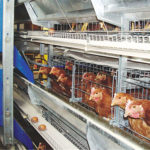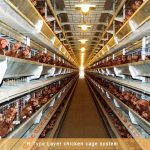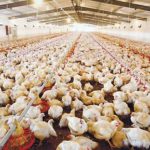Large-scale aquaculture plants use chickenpoultry farming equipmentto raise laying hens, so that the utilization rate of the land is relatively high and more chickens can be raised, which can bring better economic benefits. In summer, chickens have an impact on chickens.
First, the effect of high temperature on chicken
The normal growth temperature of chickens is 20-33 ° C. If the temperature continues to rise above the limit temperature, some of the heat dissipation function of the body is blocked, so that the heat dissipation is reduced. On the other hand, the thermal energy of the external environment can also enter the body through radiation and convection. As a result, the body temperature rises. The increase in body temperature will cause a series of adverse effects such as central nervous system dysfunction, and finally form a so-called heat-shooting disease, which gradually leads to death. All kinds of animals can’t stand the high temperature. Animals can’t live for a long time in an environment where the temperature is higher than 5 °C, and the body temperature will exceed 45 °C.
Second, the impact of air humidity on the chicken
The effect of air humidity on chickens is mainly based on heat balance, and there are some indirect effects. The suitable growth humidity of chickens inlayer chicken cageis generally 60%-70%. In order to correctly analyze and master the effects of gas and moisture on chickens, it can be considered that more than 70% is high humidity and less than 60% is low humidity. If high temperature and high humidity make the most important way of heat dissipation of chickens, it will be difficult to evaporate and heat up, which will aggravate the adverse effects of high temperature on chickens. If high temperature and low humidity, the evaporation and heat dissipation of chickens will be smooth, which can alleviate the adverse effects of high temperature on chickens. If the temperature is appropriate and the humidity is too high, the resistance of the chicken is weakened, which is beneficial to the spread of infectious diseases, and once it is ill, it is difficult to control.

Third, the impact of airflow on chicken
The state of the airflow is usually expressed in terms of wind direction and wind speed. The power of air flow in the chicken house. First, the wind outside the house enters the house through doors, windows, vents and all gaps, causing the exchange of air inside and outside the house. Second, due to the operation of the mechanical ventilation equipment, the house is kept inside. Suitable for orderly airflow conditions. In the summer with high temperature, the air flow is beneficial to the heat dissipation of the chicken body, which can alleviate the adverse effects of high temperature, and thus has a good effect on the maintenance and productivity of the chicken body heat balance. If the airflow speed in the summer house is maintained at about 0.5 m/s, it is better if the open or semi-open type can reach 1.0-1.5 m/s.
Fourth, the impact of microorganisms in the air
Due to the lack of moisture and nutrients in the clean air, there may be ultraviolet bactericidal effects, so microorganisms cannot reproduce in the air, and most of them will die very quickly. Only some bacteria and fungi that are strong in resistance and dry can be in the air. Survive for a while. However, due to the wide and easy source of the source, various microorganisms are floating in the air anytime and anywhere, especially in the chicken farms and in the air of the house, and may also contain pathogenic microorganisms, which brings serious harm to the production of chickens. The number of microorganisms in the air of the chicken house far exceeds the content of the atmosphere, especially in the environment of poor ventilation and long-term high humidity. The microbial content is relatively high. These microorganisms are generally saprophytic bacteria, and the accumulation of saprophytic bacteria will reduce the oxygen
content of the environment. It is easy to cause respiratory and E. coli diseases in livestock and poultry. Pathogenic microorganisms are generally absent in fresh environments and are only found in diseased areas. In order to prevent and control the spread of pathogenic microorganisms and kill saprophytic bacteria, the culture environment must be disinfected regularly.
Therefore, the environmental control technology in summer chicken houses and chicken cages must not only ensure proper temperature but also ensure proper humidity, so as to avoid unnecessary loss caused by high temperature, high humidity or low humidity.






